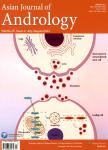Reduced corporal fibrosis to protect erectile function by inhibiting the Rho-kinase/LIM-kinase/ cofilin pathway in the aged transgenic rat harboring human tissue kallikrein 1
Reduced corporal fibrosis to protect erectile function by inhibiting the Rho-kinase/LIM-kinase/ cofilin pathway in the aged transgenic rat harboring human tissue kallikrein 1作者机构:Department of Urology Tongji Hospital Tongji Medical College Huazhong University of Science and Technology Wuhan 430030 China Institute of Urology Tongji Hospital Tongji Medical College Huazhong University of Science and Technology Wuhan 430030 China Department of Reproductive Medicine the First People's Hospital of Yunnan Province Kunming 650032 China Division of CardiologyDepartment of Internal Medicine Tengji Hospiial Tongji Medical College Huazhong University of Science and Technology Wuhan 430030 China.
出 版 物:《Asian Journal of Andrology》 (亚洲男性学杂志(英文版))
年 卷 期:2017年第19卷第1期
页 面:67-72页
核心收录:
学科分类:10[医学]
基 金:supported by the grant from the National Natural Science Foundation of China
主 题:aged corporal fibrosis erectile dysfunction gene therapy hKLK1
摘 要:Our previous studies have demonstrated that erectile function was preserved in aged transgenic rats (TGR) harboring the human tissue kallikrein 1 (hKLK1), while the molecular level of hKLK1 on corporal fibrosis to inhibit age-related erectile dysfunction (ED) is poorly understood. Male wild-type Sprague-Dawley rats (WTR) and TGR harboring the hKLK1 gene were fed to 4- or 18-month-old and divided into three groups: young WTR (yWTR) as the control, aged WTR (aWTR), and aged TGR (aTGR). Erectile function of all rats was assessed by cavernous nerve electrostimulation method. Masson's trichrome staining was used to evaluate corporal fibrosis in the corpus cavernosum. We found that the erectile function of rats in the aWTR group was significantly lower than that of other two groups. Masson's trichrome staining revealed that compared with those of the yWTR and aTGR groups, the ratio of smooth muscle cell (SMC)/collagen (C) was significantly lower in the aWTR group. Immunohistochemistry and Western blotting analysis were performed, and results demonstrated that expression of a-SMA was lower, while expressions of transforming growth factor-β1 (TGF-β1), RhoA, ROCK1, p-MYPT1, p-LIMK2, and p-cofilin were higher in the aWTR group compared with those in other two groups. However, LIMK2 and cofilin expressions did not differ among three groups. Taken together, these results indicated that the RhoA/ROCK1/LIMK/cofilin pathway may be involved in the corporal fibrosis caused by advanced age, and hKLK1 may reduce this corporal fibrosis by inhibiting the activation of this pathway to ameliorate age-related ED.



